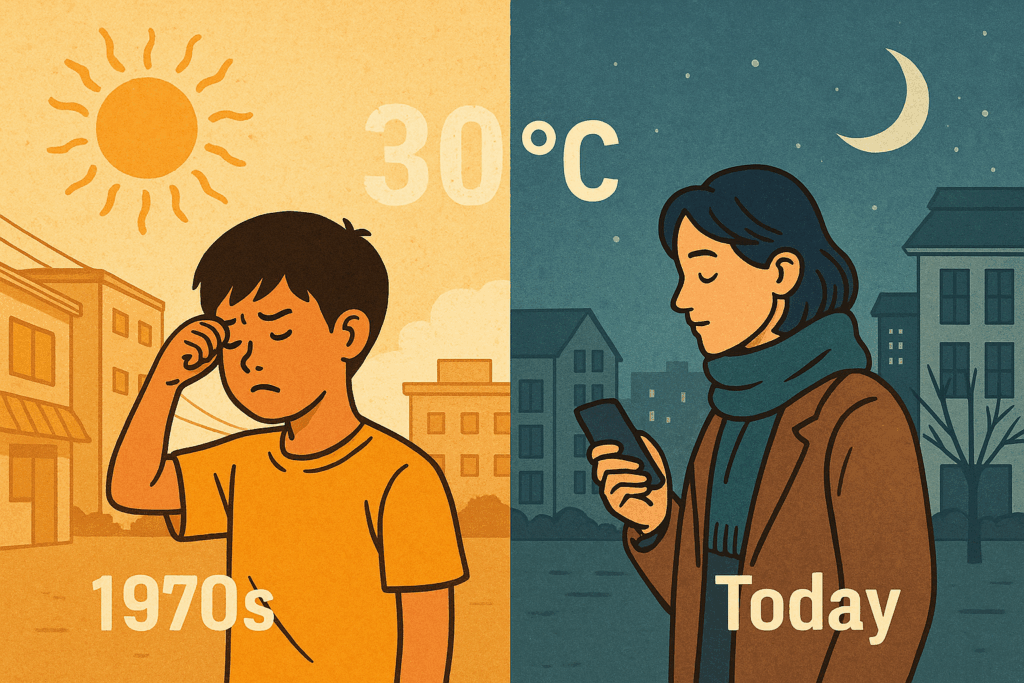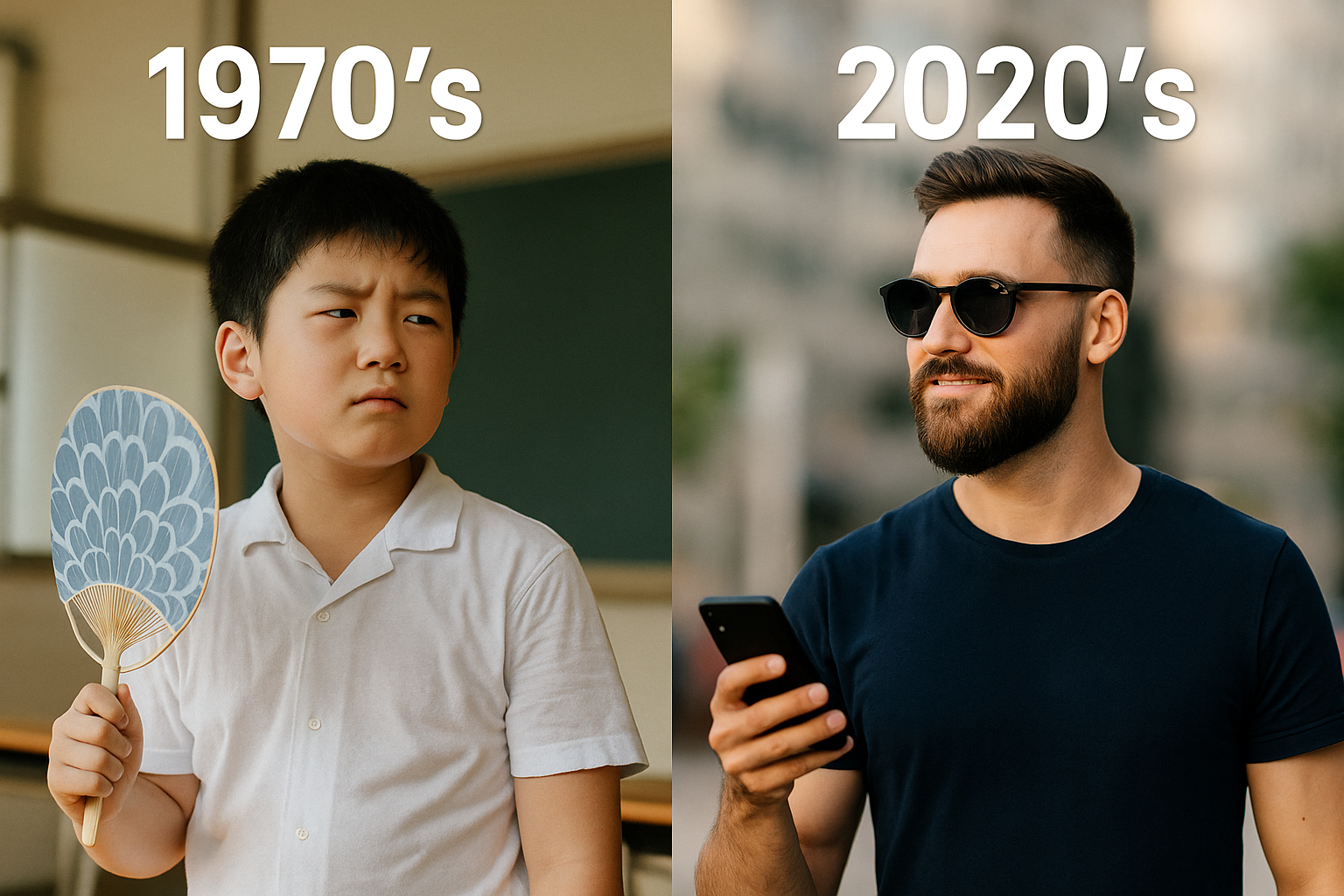ここ数日、夜の空気ががらりと変わった。
先週までの熱帯夜が嘘のように、窓を開ければひんやりとした風が頬を撫でる。
気温計の数字は22℃。本来なら快適と呼べるはずの気温なのに、今年の夏を思い返すと「肌寒い」とすら感じてしまう。身体がまだ40℃近い灼熱を記憶しているからだろう。
ふと、この体感の変化を“写真”に置き換えてみたくなる。
同じ22℃を示す数値でも、撮影された時代や背景によってそこに映る意味は全く違って見えるのではないか。

昔の30℃、今の30℃
僕が子どもの頃、30℃を超えると「今日は危険だから外に出ないように」と学校から注意があった。光化学スモッグ注意報が頻繁に発令され、外で遊ぶどころか窓を閉め切って過ごすことさえあった。教室にはエアコンなんてなく、団扇であおぎながら先生の声を聞いた。30℃は、夏の暑さの限界を示す“境界線”だった。けれど2020年代の今、30℃はもはや「ちょっと暑い日」に過ぎない。
関東地方では35℃以上が当たり前になり、40℃を超える地域も珍しくなくなった。
僕自身、車の外気温計で44℃を2度見た。もはや笑うしかない数字だった。
もし、この「30℃の夏」を1970年代と2020年代で並べて写真に収めたとしたら、まったく違う顔になるだろう。
昔なら「猛暑日の象徴」として記録された30℃も、今では「まだマシな日」として記憶される。
写真は同じ数値を示しても、その背景にある時代の感覚を無言で語るのだ。
体感温度という“心の写真
気温そのものは数値で表される。
しかし実際に「暑い」「涼しい」と感じるのは、身体に刻まれた記憶の積み重ねだ。
人間の体は環境に慣れ、その慣れが体感をつくり変えていく。
だから、22℃の写真を撮るときに添えるキャプションも、時代によって変わるだろう。
「快適な夜風」だったり「急に寒くなった秋の入口」だったり。
同じ気温を示す一枚の写真にも、そこに写る人の表情や仕草、背景の街の様子が加わることで、体感温度という“心の写真”が焼き付けられていく。
今年の夏を写すなら
今年の夏を写真に残すとしたら、何を切り取るだろうか。
きっと、白くかすむアスファルトの照り返し。
信号待ちの人々が日陰に肩を寄せ合い、ペットボトルを握りしめる姿。
熱気に揺らぐ遠くの景色や、夕立のあとの蒸し返すような湿気。
その一方で、今の夜の写真に写るのは、窓辺でそっと風を受けながらブランケットを羽織る自分の姿かもしれない。
数字以上に雄弁なのは、そこに漂う“空気感”だ。
写真は気温を写し出す道具ではないけれど、気温がもたらす心と身体の変化を切り取ることができる。
写真がつなぐ過去と現在
僕はよく思う。
もし1970年代の夏休みの教室と、2020年代の真夏日の街角を、並べて一冊のアルバムにしたらどうなるだろうか。
団扇を仰ぐ子どもたちの写真と、コンビニの冷気で一息つく大人たちの写真。
どちらも「暑さ」という共通のテーマを持ちながら、まるで違う物語を語っている。
そこには、時代ごとに変わってきた“暑さの限界点”がくっきりと浮かび上がる。
同じ30℃、同じ22℃。
でも、その写真に込められる意味はこんなにも違う。
だからこそ、写真はただの記録ではなく、感覚や記憶を引き継ぐ証人なのだと思う。
未来のアルバムを想像する
想像してみる。
もし未来の誰かが「1970年代」「2020年代」「2050年代」の夏を一冊にまとめたアルバムを手にしたら、どんな印象を受けるのだろう。
そこには扇風機の前でスイカを食べる子どもたちと、クーラーの効いた部屋でスマホを握る大人たち、さらに真夏でも冷却ベストを着て外を歩く未来の人々が並んでいるかもしれない。
そのアルバムは、単なる懐かしさや進化の記録ではなく、「人がどうやって暑さと共存してきたか」を示す証拠になるだろう。
写真は過去を閉じ込めるだけでなく、未来に問いかける役割も持つのだ。
これからの“暑さ”を記録する
気候変動が進み、これからさらに暑さの基準は変わっていくだろう。
未来の子どもたちが「40℃?まぁ普通だよ」と笑う時代が来るかもしれない。
そのときに残された写真が、僕らの「暑かった夏」の感覚を伝えてくれるだろう。
写真は未来への手紙だ。
気温の数字と一緒に、人間の表情や暮らしの断片を残しておくことで、未来の誰かに「その時代の暑さの意味」を届けられる。
おわりに
夜風に震えながら、ふと思う。
この“少し肌寒い”22℃の感覚も、数十年後には「心地よい初夏の夜」と表現されるのかもしれない。
体感は時代とともに変わるけれど、その瞬間を写真に収めれば、僕たちの“今の感覚”は確かに残る。
だから、今夜の窓辺の涼しさを、カメラに収めておこうと思う。
それは気温の記録以上に、「2025年の夏の終わり」を伝える一枚になるはずだから。
🔗あわせて読みたい記事
・「雨と紫陽花 ― 静けさの中に咲く色」
梅雨の静けさを彩る紫陽花を写したエッセイ。
・「夜が、忘れていたことを思い出させてくれる」
夜の静寂が心に眠る感情を呼び覚ます文章。
The Same Temperature, Different Faces — Photos That Speak of “Heat” in Our Memories
hese past few nights, the air has changed dramatically.
The sweltering tropical nights from just last week feel like a lie, and when I open the window, a cool breeze brushes against my cheek.
The thermometer reads 22°C. Normally, that number should mean comfort, yet after recalling this summer’s blazing heat, it feels almost cold. Perhaps my body still remembers the 40°C days.
It made me want to translate this change in sensation into “photographs.”
The same 22°C, captured in different eras and contexts, would carry entirely different meanings.

30°C Then, 30°C Now
When I was a child, a day above 30°C meant school warnings: “It’s dangerous to go outside today.”
Photochemical smog alerts were frequent, and we spent days sealed indoors.
Classrooms had no air conditioning; we fanned ourselves while trying to listen to the teacher. For us, 30°C was the boundary of summer heat.
But in the 2020s, 30°C is simply “a somewhat hot day.”
In the Kanto region, 35°C is commonplace, and surpassing 40°C is no longer unusual.
I myself saw 44°C on my car thermometer twice. A number so absurd, all I could do was laugh.
If we placed a photograph of “30°C in summer” from the 1970s next to one from the 2020s, they would look entirely different.
What was once “the symbol of an extreme heat day” is now “a tolerable day.”
The photo may show the same number, but the era silently changes its meaning.
Sensation as a “Photo of the Heart
Temperature is expressed in numbers.
Yet whether we feel “hot” or “cool” depends on memories etched in our bodies.
We adapt to environments, and that adaptation transforms perception.
Thus, a caption attached to a 22°C photo will vary with the era.
“Comfortable night breeze,” or “suddenly cold, the gateway to autumn.”
The same number on a thermometer can frame vastly different photos, because faces, gestures, and cityscapes surrounding it etch a “photo of the heart.
Capturing This Summer
If I were to capture this summer in photos, what would I choose?
Perhaps the glaring reflection of asphalt, hazy with heat.
People at intersections, huddling in shade, gripping water bottles.
The quivering horizon distorted by rising air, and the suffocating humidity after sudden downpours.
Meanwhile, tonight’s photos might show myself at the window, wrapping in a blanket as the breeze enters.
More eloquent than numbers is the “atmosphere” that lingers in the frame.
Photography may not record temperature, but it can capture how heat shapes mind and body.
Photos Bridging Past and Present
I often wonder.
If we put a classroom from the 1970s summer vacation next to a 2020s city street on a scorching day, what would the album look like?
Children fanning themselves in classrooms, adults taking a break in the cool air of a convenience store.
Both tell stories of “heat,” yet each conveys a completely different world.
The shifting “limits of heat” through time would stand out vividly.
The same 30°C, the same 22°C.
But the photos’ meanings diverge.
That’s why photography is not mere record-keeping; it is the witness to sensations and memory.
Imagining the Album of the Future
Imagine this: someone in the future holds an album titled “1970s, 2020s, 2050s Summers.”
What would they feel as they turned its pages?
Perhaps children eating watermelon in front of fans, adults glued to smartphones in air-conditioned rooms, and future people wearing cooling vests even on ordinary days.
That album wouldn’t just be nostalgia or progress; it would testify to how humans adapted to heat.
Photography doesn’t just preserve the past — it questions the future.
Recording the Heat to Come
As climate change advances, our standards of heat will shift again.
Children of the future may laugh and say, “40°C? That’s just normal.”
Then, the photos we leave will carry the sense of “the hot summers we lived through.”
Photography is a letter to the future.
By preserving numbers alongside human faces and fragments of daily life, we can deliver “the meaning of heat in our time” to those yet to come.
In Closing
Shivering in tonight’s breeze, I wonder:
This “slightly chilly” 22°C may one day be remembered as “a pleasant early-summer night.”
Sensation evolves with time, but capturing it preserves our present feelings.
That’s why I want to photograph tonight’s cool air by the window.
It will be more than a record of temperature — it will be an image that conveys “the end of summer, 2025.
🔗Related Articles
・“Rain and Hydrangeas — Colors Blooming in the Silence”
An essay capturing the beauty of hydrangeas in the quiet rainy season.
・“The Night Reminds Me of What I Had Forgotten”
A piece about how the night brings back forgotten feelings.




コメント